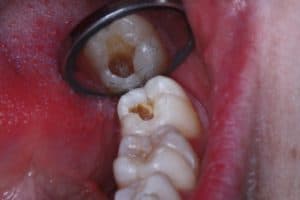We all have heard the word cavities before and have a rough idea of what it is. But one thing for sure is that we have to avoid it! Not only are they harmful for our teeth and gums, they can lead to tooth loss.
So first we are going to explain what they are. When we mention ‘cavities’ we are also referring to tooth decay. But what is exactly tooth decay? In short words it is when bacteria produce harmful acids that tear away our tooth’s enamel and dentin. Thus reaching the pulp and making our lives much harder.
How are cavities formed?
As we mentioned before, cavities are caused by bacteria. Now the process is actually pretty simple to understand:
The first step for this is when plaque starts building up. We all know that there are bacteria living naturally in our mouths, and that they feed off starchy foods and sugar. When the bacteria finds these foods, it starts converting them to acid. Plaque is a bunch of bacteria mixed with food, its own acid and some elements of our saliva.
And then comes the second step where the acids starts harming your enamel. And when that is done, it targets the next layer which is the dentin until it gets to the pulp of the teeth.
Once it reaches the pulp that is usually when people start feeling pain and sensitivity. Cavities are also a common cause for bad breath.
Types of cavities
There are actually different types, as not all of them affect the surface of the teeth:
Coronal cavities. This is the most common, where it affects the chewing surfaces of the teeth. Sealants are greatly recommended if the grooves and fissures of the molars are deep and prone to decay.
Recurrent decay. This is where even with fillings, crowns or inlays, the decay keeps appearing. One of the reasons being poor oral hygiene,
Baby bottle tooth decay. This is where the baby sleeps with a bottle of milk or juice in their mouths. The bottle exposes them greatly to carbohydrates and bacteria starts producing acids right away.
Root cavities. This is more often on old people and smokers due receding gums. Our teeth are protected with the enamel that is the outer layer, which is not the case for the root. Once the gums have pulled back and expose the root, it is really easy for it to decay.
 Tips to avoid cavities
Tips to avoid cavities
Okay, we know about cavities, but how about preventing them?
- We have a good oral hygiene up top. Brushing twice a day and flossing once is of utmost importance. Brush first thing in the morning and before hitting the bad and you will have a good line of defense.
- Take the most out of fluoride. There are many ways of getting fluoride, which helps remineralize and strengthen the teeth. Fluoride water, fluoride toothpaste, everything is allowed to achieve that pearly white smile!
- Of course, there is saliva production. Probably not one of the aspects most talked about, but saliva takes a huge role in cleansing and remineralizing the teeth. Los Algodones dentists recommend boosting your saliva producing with either sugarless gum or plain water.
- Watch for the amount of sweets you consume. Let’s face it, we all love sweets but if you want to keep tooth decay in a leash, you absolutely have to be careful. So keep an eye with all sodas, starchy foods, snacks, that kind of food. Instead, we recommend consuming fresh fruit, cheese and vegetables, they all help the teeth.
- Last but not least, have at least two check-ups with your dentist a year. They will tell how your teeth are faring, and suggest what would be the best course of action.
If you are interested in cheap and affordable procedures, you can contact us to reserve an appointment with the best dentists, and fluent in English, too, here in Los Algodones, Mexico!
